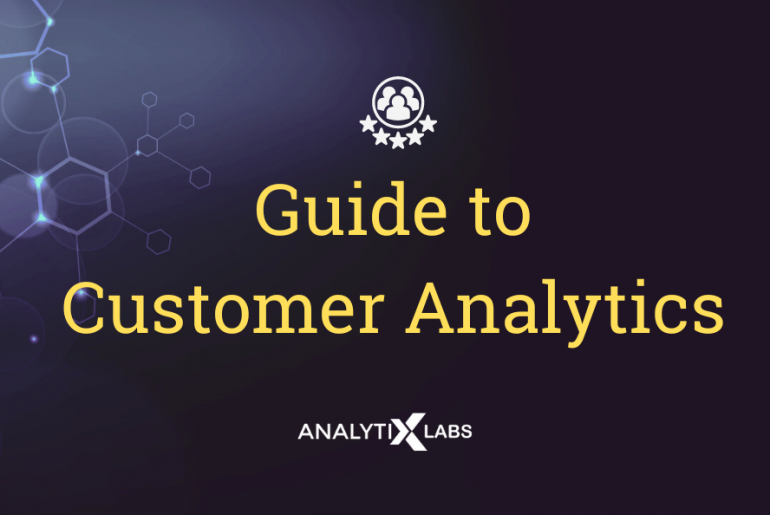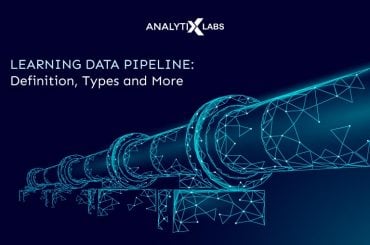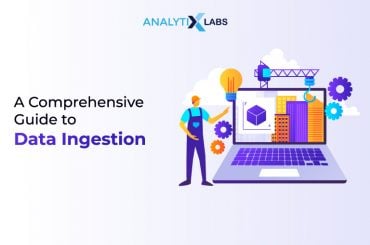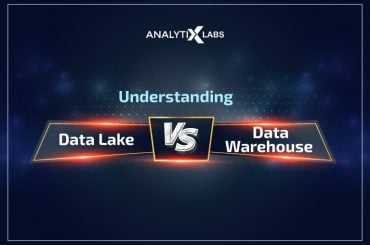Customers play an important role in determining whether a company will sustain or not. Customers who are unhappy won’t return to your website or offline store. Additionally, they will leave negative reviews on various review portals, affecting your overall brand reputation. And none of this is good for your business. Customer analytics can be your sure-shot route to avoiding such negative impacts.
Customer analytics enables companies to understand their customers better – from their browsing intent to purchase decisions – companies can know it all. Whether a company has a handful of customers or customers in thousands, millions, and billions – customer analytics can help create a tailored experience for each customer.
Why Customer Analytics?
McKinsey estimates that businesses that use customer analytics have 2.6 times more chances to have a significantly higher ROI and are three times more likely to see above-average revenue growth than their rivals.
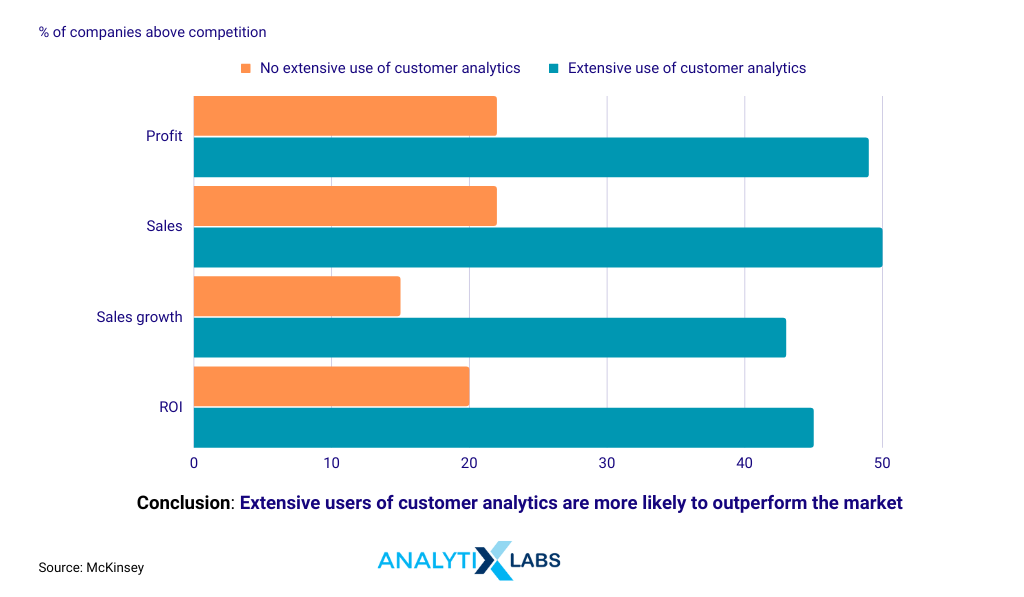
Customer analytics is the critical business process of gathering and analyzing behavioral customer data from various channels, devices, and interactions.
For instance, businesses can now collect customer data from various sources, such as social media, website visits, and shopping habits.
The data collected from these sources can be used to gain valuable insight into customer behavior, preferences, and buying patterns. Besides informed decision-making, it is useful for optimizing marketing efforts and improving the overall customer experience.
Businesses are better equipped to identify growth opportunities, increase revenue potential, and maintain loyal customers by analyzing customer data.
Advantages of using customer analytics
Customer analytics involves methods like data gathering and segmentation, modeling, and data visualization. Data is gathered from various sources, such as CRM systems, surveys, website metrics, social media channels, call center conversations, search engine queries, etc.
The data is then analyzed using various methods, such as machine learning algorithms for predictive analytics to uncover patterns in customer behaviors.
It offers the following commercial advantages:
- Enhanced consumer satisfaction and retention
- Lower lead creation and acquisition expenses
- Better sales and revenue
- Stronger brand awareness
- Higher customer engagement
There are 4 main categories of customer analytics:
- Descriptive analytics:
Descriptive analytics focuses on understanding customer behavior patterns and trends. It helps businesses understand how their customers interact with their products or services and provides insight into past performance. - Diagnostic analytics:
Diagnostic analytics digs deeper than descriptive analytics by breaking down each component contributing to specific outcomes. It looks at the cause and effect of data sets to understand better why something happened. It can help identify areas for improvement, such as marketing campaigns with lower customer engagement rates. - Prescriptive analytics:
Prescriptive analytics offers suggestions on how businesses should respond to certain events based on current data patterns. For example, it could suggest which product features should be tweaked or what pricing structure would be more profitable. It requires advanced algorithms to recommend the best course of action based on various factors and scenarios. Prescriptive analytics is often used in strategic decision-making, marketing campaigns, product design, and customer experience management. - Predictive analytics:
Predictive analytics takes diagnostic analytics a step further by leveraging historical data and machine learning algorithms to predict future outcomes accurately. It is used to develop strategies for anticipating customer behavior and trends and identify potential opportunities or risks before they arise.
Also read: Predictive analytics for a Customer-centric approach
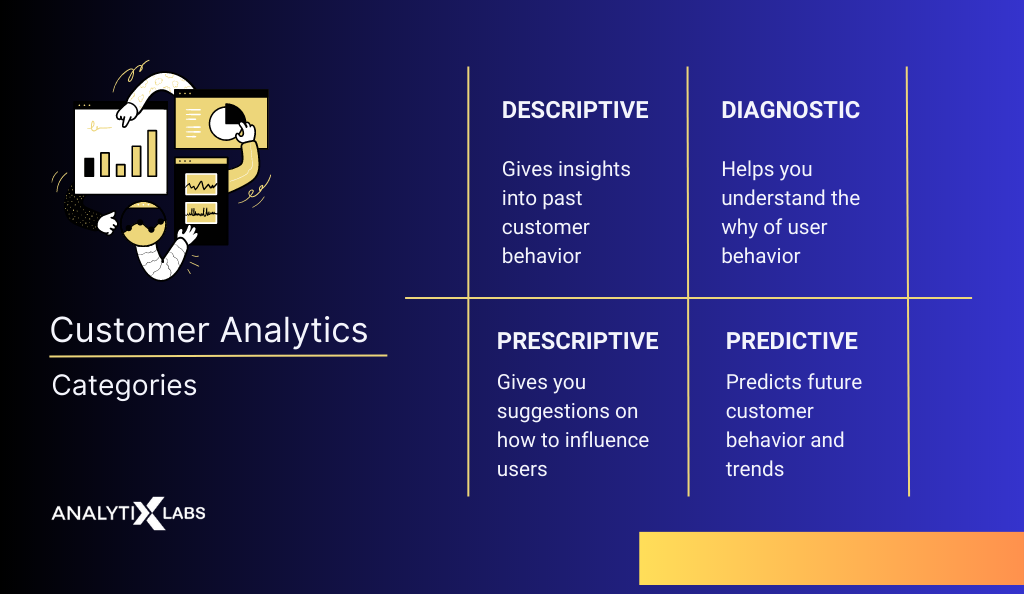
Types of Customer Analytics
While there are four categories of analytics, 3 useful types of analytics fall under one of these categories. Let’s take a look at them.
- Customer journey analytics
- Customer experience analytics
- Customer loyalty and retention analytics
Customer journey analytics
This type of analytics helps you understand customer-to-brand interactions on a deeper level. It tracks and analyzes the entire journey – from a lead to a paid user.
It is a mix of various touchpoints from different interactions. Each touchpoint indicates the stage of the customer journey. For instance –
Traffic to your demo page indicates the initial stage of the customer journey. Your potential leads are looking to gather information.
The customer journey map will be different for each business. For an eCommerce store, the journey is shorter than for a B2B software platform. Similarly, retention mechanisms are also going to be different for each business.
Customer experience analytics
This type of analytics helps you dig deeper into how customers feel while interacting with your brand. You can also call this sentiment analysis which helps brands gauge customer sentiments to design customer experience better.
Whether it is the customer support (like resolving an issue quickly), onboarding a new customer, or retaining an existing user, customer interaction analytics help brands understand user sentiments across various interactions.
One example is running social analytics to track and monitor what customers say and how. Here’s our guide to running sentiment analysis on Twitter.
Customer loyalty and retention analytics
Customer loyalty is earned; you want to keep it once you earn. Customer loyalty analytics help you understand how loyal your customers are. You get answers to queries like – who are your repeating users? What is your customer churn rate? What percentage have not returned or made a purchase in the last 30/60/90 days? etc.
These metrics tell you if your users like you more than your competitors. One of the most common ways to measure loyalty is the NPS – Net Promoter Score survey. It is a tried and tested formula.
Remember seeing questions like – how likely are you to recommend us to your friend, and you have a 1-10 score marker – yep! That’s the loyalty test.
Similarly, retention metrics can help you create a better user experience that will make your users want to stay.
-
Customer lifetime value analytics
In most cases, customer journey and customer experience analytics overlap with customer lifetime analytics. However, one important metric – Customer Lifetime Value (CLTV)- shows you how much revenue a customer can bring to your business throughout the lifetime i.e. business relationship.
The CLTV calculation formula will differ for each business. However, putting it broadly, the CLTV can be calculated as:
(Average retention rate x Average no. of purchases) x Average deal total.
This simple formula can get more complex depending on your business. This helps in segmenting customers based on the “value” it contributes. Obviously, you will pay more attention to customers bringing in the highest revenue for your business.
How to Collect & Store Data for User Analytics?
Customer analytics data is a valuable asset for organizations. Here is how you can collect and store customer analytics data:
- Web Tracking:
Place a tracking code on your website, such as Google Analytics or any other web analytics service. This will allow you to track the performance of your website, customer behavior, and customer journey. - Social Media Tracking:
Regularly monitor and analyze data from social media platforms like Twitter or Facebook. Through this tracking, you can gain insights regarding customer sentiment and feedback about your products & services. - Customer Surveys:
Gather feedback directly from customers through surveys or questionnaires. Ask questions that provide insight into how customers view and interact with your brand, products/services, customer experience, etc. - Transactional Data:
Analyze customer purchase history and trends to understand customers’ buying behavior. It will help you identify where customers are coming from and their interests. - Marketing KPIs:
Measure the performance of your marketing campaigns with analytics tools better to optimize your ads, landing pages, and more. Identify areas of improvement to drive more engagement and conversions. - Data Storage:
Use a cloud-based system like Amazon S3, Microsoft Azure Cloud Storage, or Google Cloud Platform to store collected customer analytics data securely. - Data Visualization:
Use tools like Tableau or PowerBI to generate meaningful insights from the collected data. It helps you better understand customer preferences and use that knowledge to create campaigns and products tailored to their needs.
Use Cases
Customer Analytics can be leveraged to gain a deeper understanding of customer behavior. This knowledge, combined with predictive analytics and machine learning algorithms, can help businesses make better decisions that improve customer engagement, loyalty, and revenue growth. Some use cases for Customer Analytics include:
-
Customer segmentation
You can categorize customers based on common characteristics. It enables businesses to identify customer segments and create targeted campaigns that cater to the unique needs of each segment.
A thorough application of customer analytics techniques aids market targeting based on precise insights and indicators. It analyzes the segments of people who are most interested in what your organization has to offer.
Using these customer analytics applications, you may make data-driven decisions for each aspect of your organization. In addition, you may be able to identify entire markets you didn’t know existed using the same data.
-
Churn prevention
Churn prediction aids in identifying the clients most likely to discontinue our services, such as canceling their subscriptions.
Customer analytics models prevent customer churn by examining customer dissatisfaction among your current clients and identifying client categories most likely to leave. With the use of predictive analytics, businesses can make the necessary adjustments to keep customers delighted and, ultimately, secure their revenue.
-
Predictive maintenance
In organizations, controlling costs is crucial to boosting sales. However, an organization finds it challenging to control capital expenditure when it has made considerable infrastructure and equipment investments.
Machine learning techniques for predictive maintenance help companies define timeframes for maintenance events and forecast impending spending needs by streamlining the maintenance cost and downtime.
By studying the insights and metrics of the maintenance cycle of technical equipment, you can take steps to prolong the life of your equipment and minimize downtime.
-
Quality assurance
The success of your business operations and the quality of your client experience depend on quality assurance. Ineffective quality control will impact customer satisfaction levels, ultimately influencing revenue and market share.
Inefficient production also increases expenses for customer assistance, warranty problems, and repairs. Insights into possible quality concerns and trends can be provided by industries utilizing customer analytics use cases before they become serious difficulties.
Utilizing customer analytics helps speed your time to market through shift-left testing and helps identify high-risk application modules and crucial regions. The way you approach QA changes from being reactive to proactive with the use of predictive analytics.
How to Use Customer Analytics?
Customer analytics can measure your marketing activities’ success by tracking conversions and engagement metrics such as page views or time spent onsite. The data can be used to improve your marketing strategy. You can use customer analytics to
- Target the correct audience with the right campaigns
- Increase personalization of both content and product features
- Send appropriate messages through the preferred channels at the right time
- Streamline customer experience throughout their journey
- Contribute to new product development and improve existing ones based on customer feedback
Additionally, customer analytics tools provide valuable insight that can be used for customer segmentation. You can use them to tailor your products and services based on the different categories of customers. It helps reduce customer acquisition costs, maximize the effectiveness of your campaigns, and optimize pricing for maximum profitability.
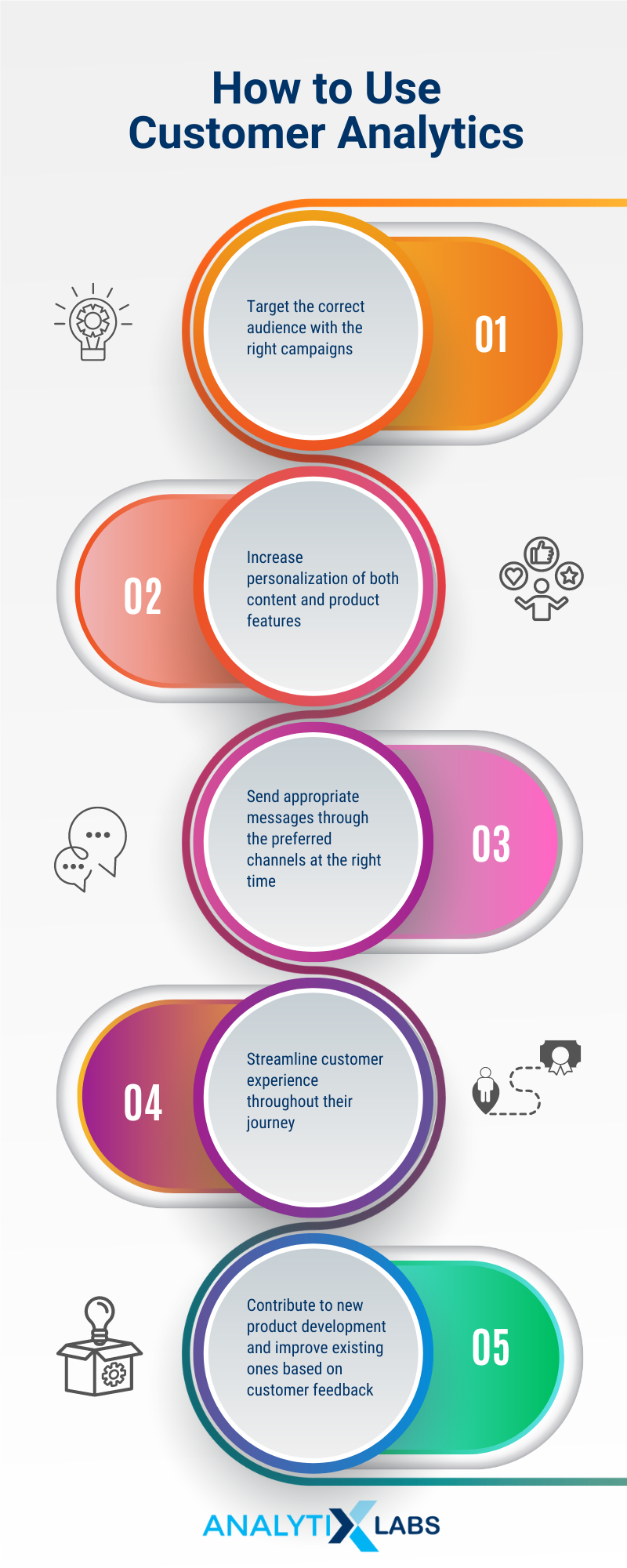
Customer Analytics: Applications
Customer analytics offer a 360-degree view of customer behavior. It enables organizations to understand customer behavior, improve customer experience and gain a competitive edge.
Companies can anticipate trends and identify growth opportunities by understanding customer activity data. In addition, they can use the insights for procedures like management, pricing, and promotion.
The essential applications of customer analytics are:
- Customer Acquisition: Utilizing customer analytics can help you identify target customers and optimize campaigns to drive successful customer acquisition.
- Customer Retention: By measuring customer engagement, usage patterns, product preferences, and satisfaction levels, you can better understand the factors influencing customer loyalty. Leveraging customer data lets you identify why a customer left. You can develop proactive strategies for reducing customer churn.
- Cross-Selling and Upselling: By understanding what products individual customers may be interested in or need additional support, businesses can create personalized customer experiences to encourage cross-selling and upselling opportunities.
- Marketing Optimization and Personalization: Businesses can uncover insights into the best ways to reach their target audiences with tailored messages that provide maximum impact using predictive analytics techniques such as machine learning algorithms.
- Fraud Detection and Prevention: Data-driven fraud detection models help businesses mitigate potential losses from fraudulent activities such as theft and money laundering.
- Customer Service and Support: By leveraging customer data to understand their preferences and experiences with the brand, businesses can provide real-time customer service and support to drive an enhanced customer experience.
- Analyzing and Improving Experiences: Using analytics techniques such as Natural Language Processing (NLP) and sentiment analysis, businesses can gain valuable insights into customer attitudes and how they interact with products or services. Their feedback can then be used to address pain points.

Tools for User Analytics
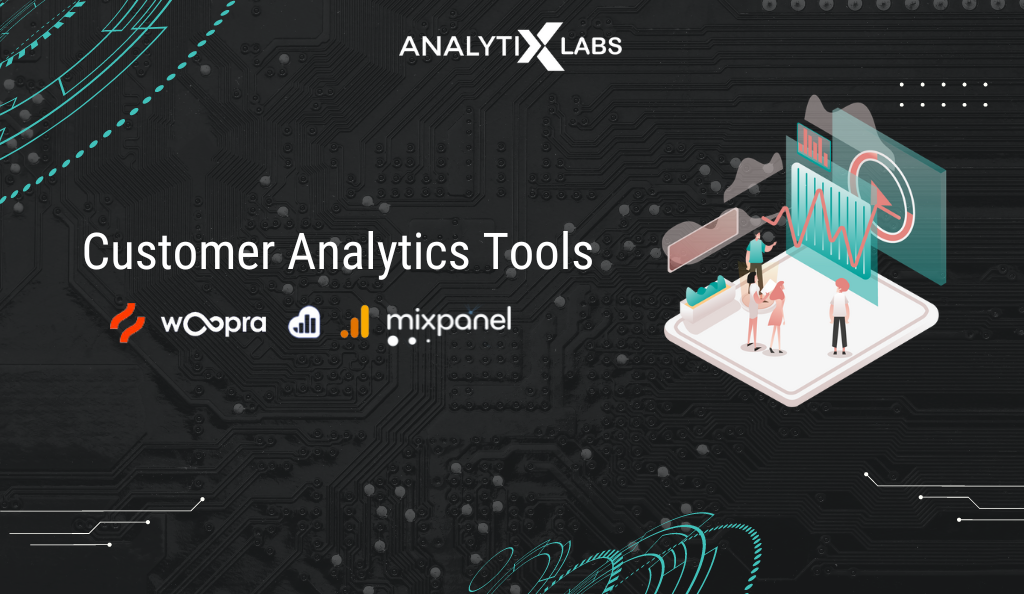
Customer analytics tools help businesses collect data such as customer behavior in product or service usage and demographics (e.g., gender, age range). The data can be further analyzed to identify patterns of buying habits among different segments of customers.
The most recommended tools for customer analytics in 2023 are:
Mixpanel

Mixpanel is the most trustworthy and well-liked eCommerce analytics solution. It enables you to monitor conversions, follow user behavior across devices, and assess how your audience interacts with your store.
Mixpanel was created with the purpose of enabling all businesses, regardless of size, to monitor and analyze customer activity in real time. The platform makes tracking client activity simpler for organizations, especially those with limited resources in terms of time and money.
Users can send emails instead of entering SQL queries into their app’s data because Mobile Analytics powers it. No prior technical knowledge is necessary for users to get the desired results. Email generation is easy, thanks to the software’s query visualization tool.
Expedia, Uber, Ancestry, DocuSign, and Lemonade are just a few of the 26,000 companies Mixpanel has worked with worldwide.
Features:- Easy integration with other platforms
- Data access in real-time
- A/B Testing and messaging
- Behavioral analytics
- Easy-to-Use Interface
- Funnel reporting
- Specific Data Collection
- Simple Analytics
- Targeted Data Collection
Google Analytics

Google Analytics is the largest online analytics software available. It provides websites with tools that are both free and paid for so that they can better analyze their users’ behavior and learn more about them. Small and medium-sized businesses will benefit greatly from Google Analytics’ free plan.
The free plan is loaded with helpful features, including data analysis, reporting, data collecting and administration, connectors, and more.
You may get the most out of the information that has been acquired by using multiple degrees of data processing, monitoring, and filtering, including segmentation, funnel analysis, progress monitoring on dashboards, and many other techniques.
Features:- Data management and user access control
- Easy integration
- Multiple data access points and organization tools
- Full performance insight
- Free
- Seamless integration with other Google products.
- Customizable reports, dashboards, and data collection.
- Easy to implement and easy to install
- User-friendly interface
Kissmetrics
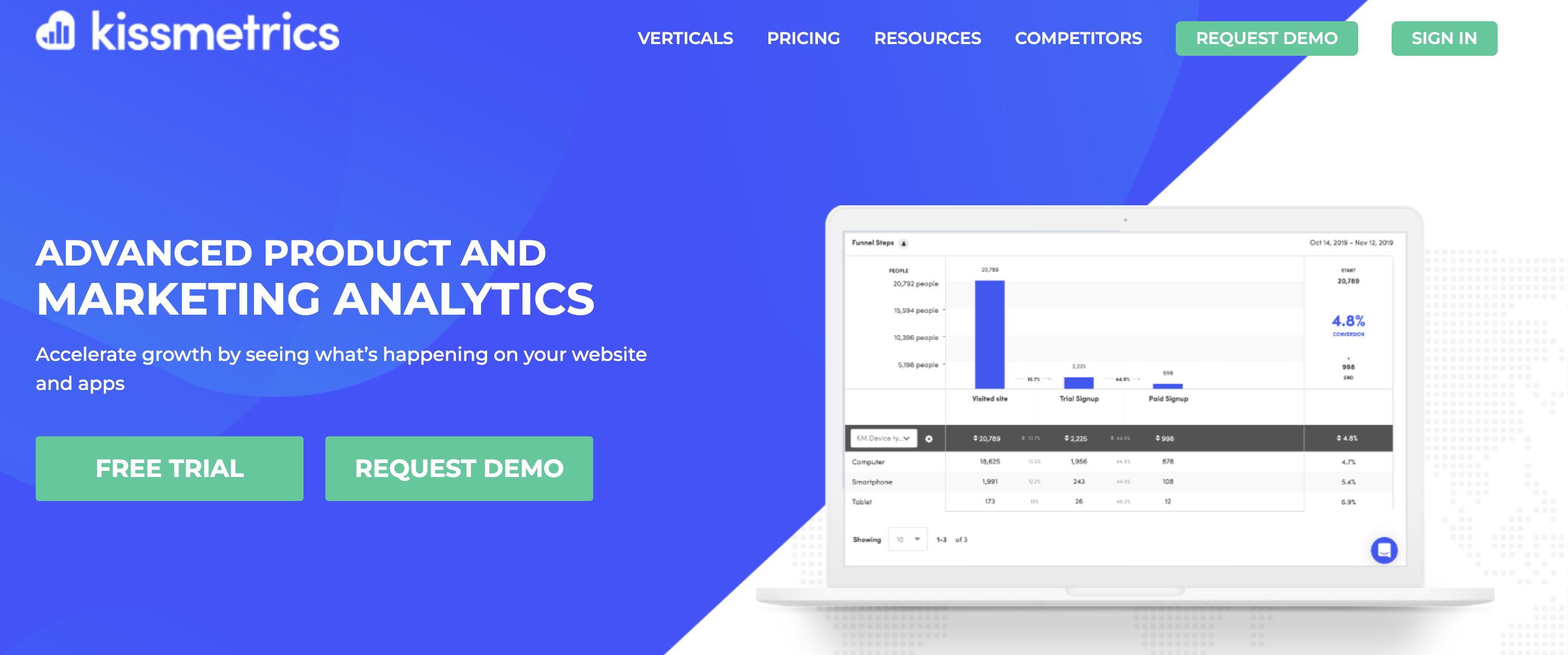
Kissmetrics strives to offer a more individualized picture of customer data, enabling you to put yourself in your customers’ shoes and providing you with practical insights into their motivations, preferences, and overall customer experience.
You will be able to see who your top customers are and what they have in common, as well as your average revenue per client and the growth rates of both new and returning consumers. Real-time reports provide immediate access to all of this data, and a unique dashboard shows all of your essential indicators.
For individuals who are seeking a more targeted solution and have outgrown Google Analytics, Kissmetrics is the ideal customer data analysis tool.
Features:- Create customized email campaigns using custom events or funnels that may be automated or done manually.
- Cross-platform behavior reports can be used to find and track bespoke audience growth categories.
- Sync with e-commerce systems to import purchasing history.
- Search for People with Similar Characteristics
- Codeless Event Tracking Setup
- Monitor your most important customers
- Test Multiple Landing Pages, A/B testing
Woopra
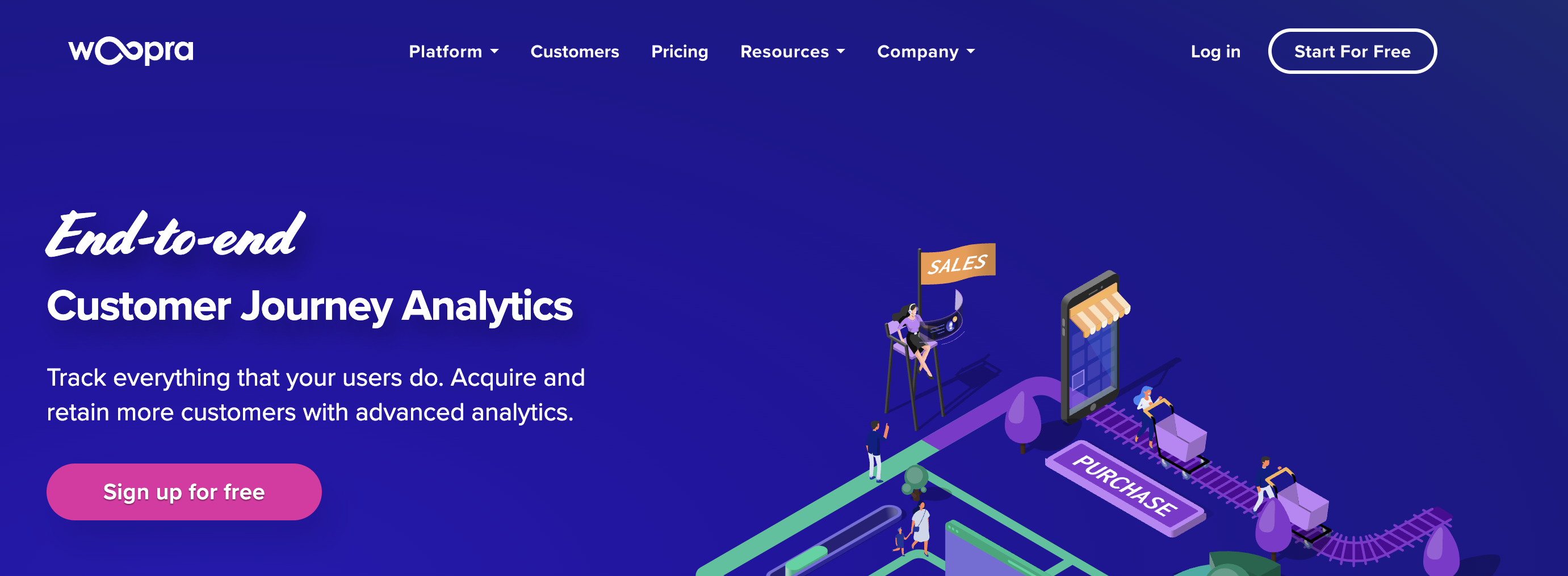
Woopra is a platform for real-time customer analytics that keeps track of user activity across product, marketing, sales, and support touchpoints. It is simple to understand and use.
It provides customer success teams with a high-level analysis of how various user categories progress through the funnel as well as specific information on the user journeys of each individual.
Woopra assists businesses in tracking visitor behavior and ultimately engaging, retaining, and converting those visitors into devoted customers.
You may view the customer journey for each site visitor by visiting their People Profiles, which Woopra offers as part of its proprietary technology.
Features:- Complete metrics
- Third-party integrations
- Customer profiles
- Advanced real-time reporting
- AppConnect Code-free Integrations
- Great UI
- Automation
- Real-time analytics
- Customizable Reports
- Beginner-Friendly
Hotjar
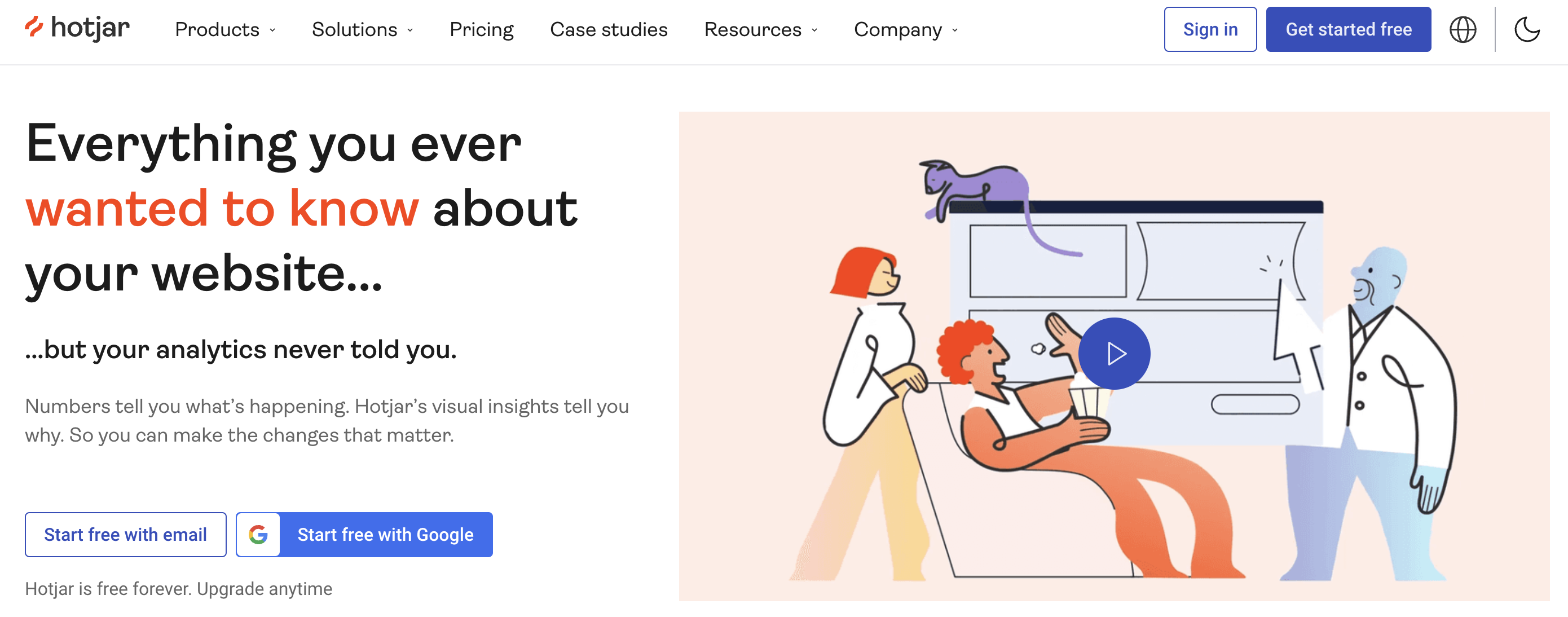
This visual customer analytics platform offers distinctive customer insights through its “heat map,” which displays the regions of your website that are receiving the most traffic.
Hotjar effectively combines several analytics features and technologies with a wide range of feedback methods into a single solution.
Hotjar uses polls, surveys, and other techniques to obtain insightful user input. Your marketing, analytics, UX, and CRO teams can make the necessary adjustments to enhance UX and conversions with the help of such a comprehensive collection of data.
Hotjar is a specialized application that is unmatched for tracking websites. It is worth considering if your website layout needs to be optimized depending on your client’s particular needs and preferences.
Features:- Heatmaps
- Visitor recordings
- Conversion funnels
- Incoming Feedback
- Feedback polls
- Quality Customer Support
- Multiple Language Support
Closing thoughts:
Customer analytics can change the face of your business if you know what to measure and how to devise a strategy around it. To summarize everything, here is a quick overview of the best practices to uphold while implementing customer analytics:
1. Define your goals and objectives
Before collecting and analyzing customer data, it is important to understand what you want to achieve clearly. It will help ensure that you collect relevant data and that your analysis is focused on the right areas.
2. Collect and organize data
Collecting a wide range of data from various sources, such as customer interactions, purchase history, and demographics, is important. Once you have your data, it is important to organize it to make it easy to analyze and interpret.
3. Use the right tools
Various tools and software are available for customer analytics, from basic Excel spreadsheets to advanced analytics platforms. Choosing the right tools for your specific needs and goals is important.
4. Identify patterns and trends
By analyzing your data, you can identify patterns and trends in customer behavior that can inform your marketing, inspire product development, and improve customer service strategies.
5. Test and iterate
Once you have identified patterns and trends, testing different strategies and seeing how they perform is important. Based on the results, iterate and refine your approach to improve performance.
6. Communicate and share insights
Share your findings and insights with relevant stakeholders so that they can understand customer behavior and develop better strategies.
7. Keep an eye on industry and customer trends
Keep an eye on the industry and customer trends, and make sure your data is up-to-date. It will ensure that your insights are still relevant and actionable.
FAQs
1. What is an example of customer analytics?
An example of customer analytics would be a retail company analyzing customer purchase history to identify patterns and trends in product popularity. Then, the company can use this information to make informed decisions about its inventory and product development decisions.
For example, if the company notices a trend of increasing sales for a certain product, it may stock more in its stores or invest in developing similar products.
They can also use this data to create targeted marketing campaigns to promote those products to customers who have shown an interest in them in the past.
2. How do you do customer analytics?
Customer analytics starts with defining your goals and objectives. After that, you must collect and organize data from various sources, such as customer interactions, purchase history, and demographics.
Once the data is collected, it is essential to use the right tools to analyze and interpret it. Identify patterns and trends in customer behavior that can inform your marketing, product development, and customer service strategies.
Keep an eye on the industry and customer trends, and make sure your data is up-to-date. Finally, share your findings and insights with relevant stakeholders and teams to be used for decision-making.

